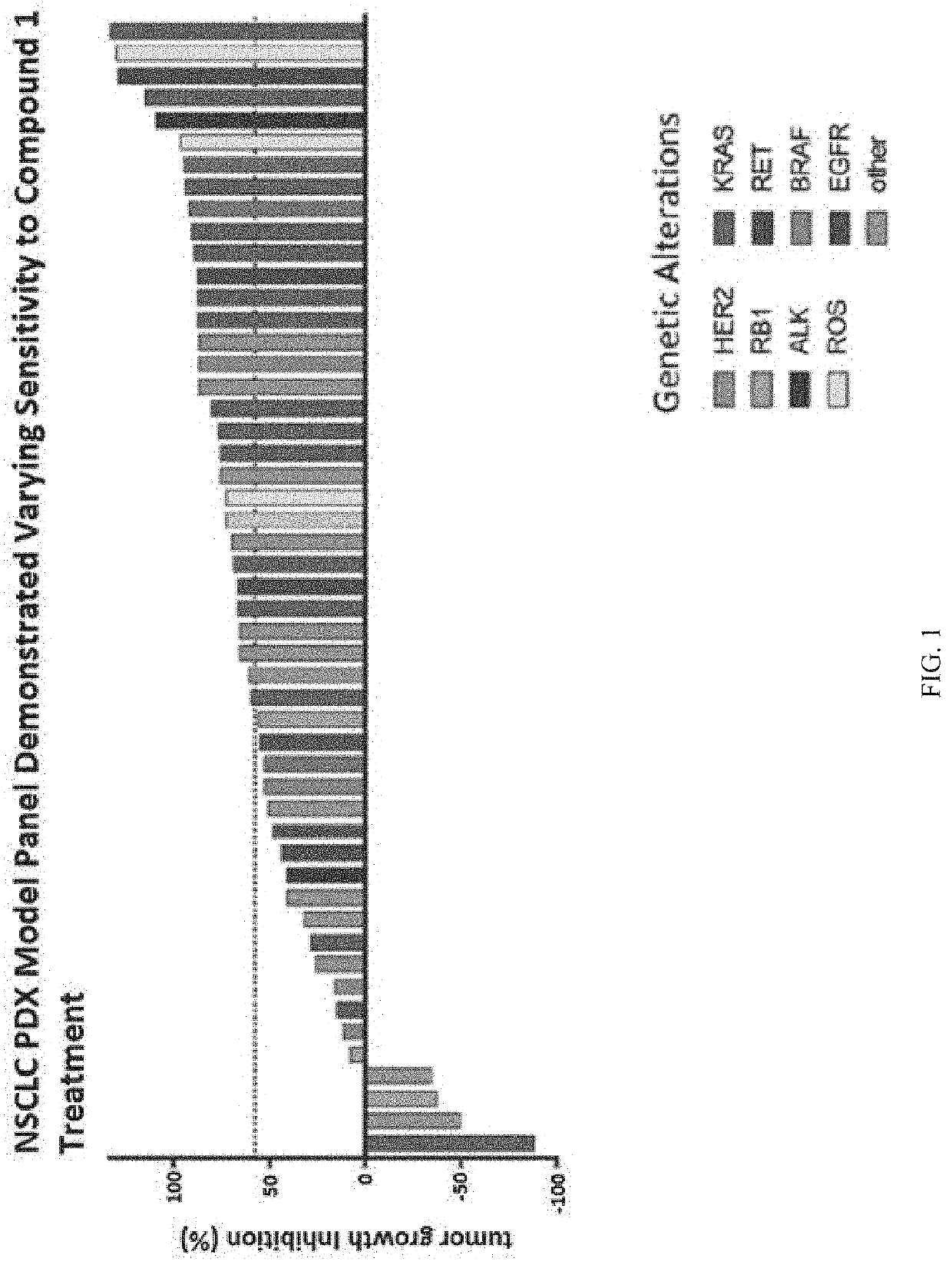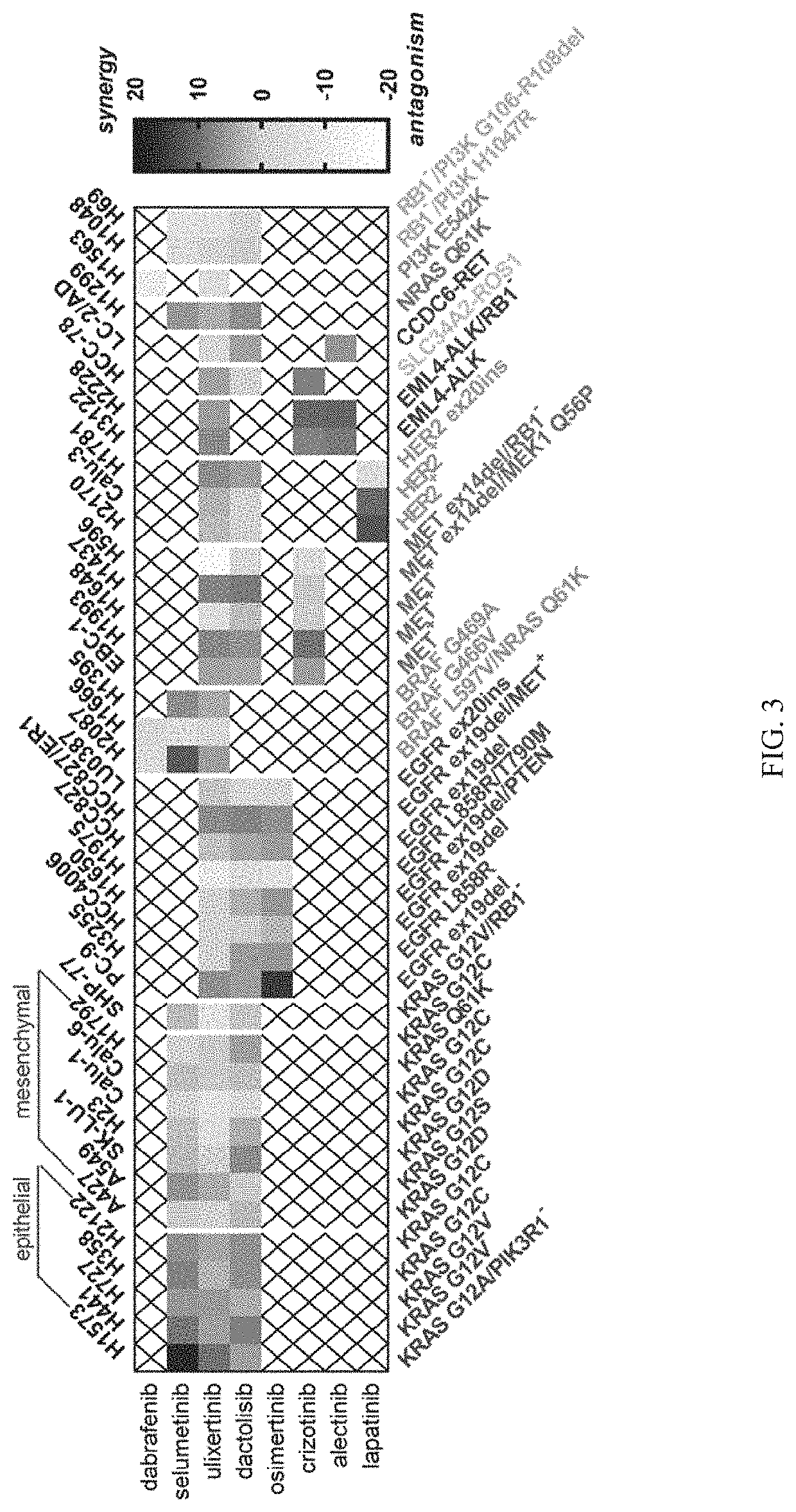Treatment of cancers having driving oncogenic mutations
a technology of oncogenic mutations and cancers, applied in the field of treatment of cancers with driving oncogenic mutations, can solve the problems of limited effectiveness of long-term therapies and major challenges in effective therapeutic strategies targeting driver mutations, and achieve the effects of preventing or delaying preventing or reducing the acquisition of acquired resistance, and reducing the risk of cancer survival
- Summary
- Abstract
- Description
- Claims
- Application Information
AI Technical Summary
Benefits of technology
Problems solved by technology
Method used
Image
Examples
example 1
DX Model Panel Demonstrated Varying Sensitivity to Treatment with Compound 1
[0225]NSCLC PDX models (n=60) were treated for up to 28 days with daily oral doses of vehicle or Compound 1 (100 mg / kg). Tumor growth inhibition (TGI) was calculated when tumors reached pre-specified tumor burden or on day 28. Genetic alterations from pre-treated samples were evaluated using FoundationOne. 58% TGI was used as the responder / non-responder cutoff for correlation analysis. As shown in FIG. 1, there was a range of efficacy associated with Compound 1 in the panel of NSCLC PDX models. Certain genetic alterations, such as KRAS and EGFR, demonstrated increased sensitivity while others, such as RB1, demonstrated resistance. The median TGI for adenocarcinoma was 73%, and the median TGI for squamous cell carcinoma was 66%.
example 2
1 Enhances the Anti-Proliferative Effect of Inhibitors Targeting Specific Oncogenic Drivers In Vitro
[0226]Lung cancer cell lines (n=40) harboring known oncogenic mutations were screen for sensitivity to Compound 1 alone or in combination with relevant targeted kinase inhibitors (Crown Bioscience, Taicang, China). As shown in FIG. 2, absolute IC50 values from single-agent treatments with Compound 1 were calculated using a 2× doubling time cell proliferation assay (minimum 3 days) and were used to guide the design of the combination treatment assay. Growth inhibitor values were used to calculate the synergy scores of Compound 1 in combination with dabrafenib, selumetinib, ulixertinib, dactolisib, osimertinib, crizotinib, alectinib, or lapatinib using the Loewe Additivity model. For the drug synergy screen of NSCLC cell lines, 9×9 combination matrices nominally centered around single-agent IC50 values were created, and cell proliferation for each condition was measured and compared to ...
example 3
on Treatment with Compound 1 Augments the Anti-Proliferative and Apoptotic Signaling Pathways
[0228]A549 (KRASG12S and CDKN2A null) NSCLC cells were treated with Compound 1 (0.5 selumetinib (1 and / or ulixertinib (1 μM) for 48 hours. Additionally, H3122 (EML4-ALK fusion) NSCLC cells were treated with Compound 1 (0.5 μM) and / or crizotinib (1 μM) for 48 hours. All cells were subjected to immunoblotting with a-tubulin used as the loading control. As shown in the immunoblots in FIGS. 4A and 4B, the enhanced efficacy of treatment combinations with Compound 1 may be due to profound suppression of RB phosphorylation coupled with an enhancement of a pro-apoptotic phenotype when compared to either single agent treatment.
Example 4. Compound 1 Enhances the Efficacy of Selumetinib and Ulixertinib Therapy in a KRASG12S NSCLC Mouse Model
[0229]A549, a KRASG12S human NSCLC xenograft model, was treated with Compound 1 and / or ERKi / MEKi in vivo (Charles River Laboratories, Research Triangle Park, N.C.)....
PUM
| Property | Measurement | Unit |
|---|---|---|
| 2theta | aaaaa | aaaaa |
| TG- | aaaaa | aaaaa |
| TG- | aaaaa | aaaaa |
Abstract
Description
Claims
Application Information
 Login to View More
Login to View More - R&D
- Intellectual Property
- Life Sciences
- Materials
- Tech Scout
- Unparalleled Data Quality
- Higher Quality Content
- 60% Fewer Hallucinations
Browse by: Latest US Patents, China's latest patents, Technical Efficacy Thesaurus, Application Domain, Technology Topic, Popular Technical Reports.
© 2025 PatSnap. All rights reserved.Legal|Privacy policy|Modern Slavery Act Transparency Statement|Sitemap|About US| Contact US: help@patsnap.com



